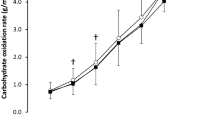Summary
The effects of obesity, exercise, and the interaction of obesity and exercise were examined in 6 caffeine naive, untrained, nonsmoking, college males (3 lean (LV), 3 obese (OV)). Each subject received caffeine (oral, 5.83 mg·kg−1 lean body weight) or placebo (50 mg citrate) prior to 3 h of seated rest and prior to 90 min of treadmill walking (40% of their maximal aerobic power) followed by 90 min of seated recovery. Serum samples were collected at various times and analyzed for caffeine by HPLC. Pharmacokinetic analysis indicated that at rest, OV had a significantly higher absorption rate constant (Ka 0.0757 vs. 0.0397 min−1), lower elimination rate constant (Ke 0.0027 vs. 0.0045 min−1), and longer serum half-life (t1/2 4.37 vs. 2.59 h) in comparison to LV. In exercise, as well as at rest LV and OV had a large difference in the volume of distribution (43.2 vs. 101. 1) (rest, 54.1 vs. 103.1). Exercise consistently resulted in a decrease in the maximal serum concentration of caffeine and the area under the curve in OV while having no consistent effect on LV. The interactive effects of obesity and exercise could not be dissociated. However, these results demonstrate that both obesity and exercise have modified the pharmacokinetics of caffeine.
Similar content being viewed by others
References
Abernethy DR, Greenblatt DJ (1982) Pharmacokinetics of drugs in obesity. Clin Pharmacokinetics 7: 108–114
Alexander JK, Dennis EW, Smith WG, Amad KH, Duncan WC, Austin RC (1963) Blood volume, cardiac output, and distribution of systemic blood flow in extreme obesity. Cardiovasc Res Cent Bull 1: 39–44
Ballard BE (1974) Pharmacokinetics and temperature. J Pharm Sci 63: 1345–1358
Blanchard J, Mohammadi JD, Conrad KA (1980) Improved liquid-chromatographic determination of caffeine in plasma. Clin Chem 26: 1351–1354
Blanchard J, Sawers SJ (1983) Comparative pharmacokinetics of caffeine in young and elderly men. J Pharm Biopharm 11: 109–126
Blouin RA, Elgert JF, Bauer LA (1980) Theophylline clearance: Effect of marked obesity. Clin Pharmacol Ther 28: 619–623
Bonati M, Latini R, Galletti F, Young JF, Tognoni G, Garattini S (1982) Caffeine disposition after oral doses. Clin Pharmacol Ther 32: 98–106
Bonati M, Latini R, Toganoni G, Young JF, Garattini S (1985) Interspecies comparison of in vivo caffeine pharmacokinetics in man, monkey, rabbit, rat and mouse. Drug Metab Review 15: 1355–1383
Bray GA (1979) Obesity. Dis Mon 26: 7–83
Callahan MM, Robertson RS, Branfman AR, McComish MF, Yesair DW (1983) Comparison of caffeine metabolism in three populations after oral administration of radiolabeled caffeine. Drug Metab Dis 11: 211–217
Colton T, Gosselin RE, Smith RP (1968) The tolerance of coffee drinkers to caffeine. Clin Pharm Ther 9: 31–39
Dews P, Grice HC, Neims A, Wilson J, Wurtman R (1982) Report of fourth international caffeine workshop, Athens. Fd Chem Toxic 2: 163–169
Fredholm BB (1985) On the mechanism of action of theophylline and caffeine. Acta Med Scand 217: 149–153
Grossman EM (1984) Some methodological issues in the conduct of caffeine research. Fd Chem Toxic 22: 245–249
Grant DM, Tang BK, Kalow W (1983) Variability of caffeine metabolism. Clin Pharmacol Ther 33: 591–602
Izzo JL, Ghosal A, Kwong T, Freeman RB, Jaenike JR (1983) Age and prior caffeine use alter the cardiovascular and adrenomedullary responses to oral caffeine. Am J Cardiol 52: 769–773
Kalow W (1985) Variability of caffeine metabolism in humans. Arzneim Forsch Drug Res 35: 319–324
Levy M, Zylber-Katz E (1983) Caffeine metabolism and coffee-attributed sleep disturbances. Clin Pharmacol Ther 33: 770–775
Lowenthal DT, Kendrick ZV (1985) Drug-exercise interactions. Ann Rev Pharmacol Toxicol 25: 275–305
McArdle WD, Katch FI, Katch VL (1981) Exercise physiology. Lea and Febiger, Philadelphia, pp 368–391
Niazi S (1979) Textbook of biopharmaceutics and clinical pharmacokinetics. Appleton-Century-Crofts, New York
Parsons WD, Neims AH (1978) Effects of smoking on caffeine clearance. Clin Pharmacol Ther 24: 40–45
Prinz WA, West DB, Prescod L, Greenwood MRC (1985) Blood volume is reduced in adipose tissue of obese Zucker rats. Fed Proc 44: 793
Ritschel WA (1985) Graphic approach to clinical pharmacokinetics. J. R. Prous, New York
Robertson D, Wade D, Workman R, Woosley RL (1985) Tolerance to the humoral and hemodynamic effects of caffeine in man. J Clin Invest 67: 1111–1117
Rowell LB, Blackmon JR, Bruce RA (1964) Indocyanine Green Clearance and estimated hepatic blood flow during mild to moderate exercise in upright man. J Clin Invest 43: 1677–1690
Schlaeffer F, Engelberg I, Kaplanski J, Danon A (1984) Effect of exercise and environmental heat on theophylline kinetics. Respiration 45: 438–442
Statland BE, Demas TJ (1980) Serum caffeine half-lives. Am J Clin Pharm 73: 390–393
Tin AA, Somani SM, Bada HS, Khanna NN (1979) Caffeine, theophylline and theobromine determinations in serum, saliva, and spinal fluid. J Anal Tox 3: 26–29
Watson PE, Watson ID, Batt RD (1980) Total body water volumes for adult males and females estimated from simple anthropometric measurements. Am J Clin Nutr 33: 27–39
Womersley J, Durnin J, Boddy K, Maheffey M (1976) Influence of muscular development, obesity, and age on the fat-free mass of adults. J Appl Physiol 41: 273–279
Author information
Authors and Affiliations
Rights and permissions
About this article
Cite this article
Kamimori, G.H., Somani, S.M., Knowlton, R.G. et al. The effects of obesity and exercise on the pharmacokinetics of caffeine in lean and obese volunteers. Eur J Clin Pharmacol 31, 595–600 (1987). https://doi.org/10.1007/BF00606637
Received:
Accepted:
Issue Date:
DOI: https://doi.org/10.1007/BF00606637




